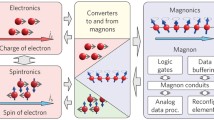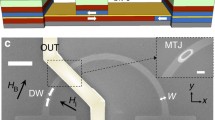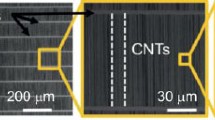Abstract
It is proposed to use transistor-transistor logic (TTL) for future fast, low-power digital electronic circuits. A relaxation quantum transistor can be the basic element of these circuits. This approach allows us to circumvent the difficulties of using field effect transistors based on nanowires.








Similar content being viewed by others
REFERENCES
Datta, S., Quantum devices, Superlatt. Microstruct., 1989, vol. 5, no. 1, pp. 83–93.
Obukhov, I.A., Electronic devices based on quantum wires: Prospects and problems, in Physics, Chemistry and Application of Nanostructures, Review and Short Notes of Nanomeeting’97, Borisenko, V.E., Ed., Belarus, Minsk, 1997, pp. 322–325.
Obukhov, I., A some aspects of nanoelectronics development in Russia, in WTEC Workshop Proceedings: Russian Research and Development Activities on Nanoparticles and Nanostructured Materials, St. Petersburg, 1997, pp. 85–92.
Datta, S., The 21st century energy efficient logic transistor, in Proceedings of the Formerly with Advanced Transistor and Nanotechnology Group Intel Corporation Hillsboro, Oregon, USA, October 9, 2007.
Das, S.R., Delker, C.J., Zakharov, D., Chen, Y.P., Sands, T.D., and Janes, D.B., Room temperature device performance of electrodeposited InSb nanowire field effect transistors, Appl. Phys. Lett., 2011, vol. 98, pp. 243504-1–243504-3.
Candebat, D., InSb nanowire field effect transistors, in Proceedings of the 67th Device Research Conference, 2009, pp. 13–14.
Yang, Z.-X. Han, N., et al., Carbon doping of InSb nanowires for high-performance p-channel field-effect-transistors, Nanoscale, 2013, vol. 5, pp. 9671–9676.
Güll, Ö., Woerkom, D.J., Weperen, I., Car, D., Plissard, S.R., Bakkers, E.P.A.M., and Kouwenhoven, L.P., Towards high mobility InSb nanowire devices, Nanotecnology, 2015, vol. 26, pp. 215202-1–215202-7.
Gazibegovic, S., Car, D., et al., Epitaxy of advanced nanowire quantum devices, Nature (London, U.K.), 2017, vol. 548, pp. 434–438.
Lojek, B., History of Semiconductor Engineering, New York: Springer Science, 2007, p. 321.
Obukhov, I.A., Neravnovesnye effekty v elektronnykh priborakh (Non-Equilibrium Effects in Electronic Devices), Moscow, Kiev, Minsk, Sevastopol’: Veber, 2010.
Voprosy kvantovoi teorii neobratimykh protsessov (Questions of the Quantum Theory of Irreversible Processes, Collection of Articles), Bonch-Bruevich, V.L., Ed., Moscow: Inostr. Liter., 1961.
Obukhov, I.A., On the possibility of creating relaxation quantum devices, Tech. Phys. Lett., 1993, vol. 19, no. 8, p. 537.
Obukhov, I.A., Planar one-dimensional quantum devices, Nanosci. Nanotechnol., 2013, vol. 3, no. 5, pp. 115–122.
Obukhov, I.A., About the frequency-dependence of electrical characteristics of quantum devices, Nanosci. Nanotechnol., 2012, vol. 2, no. 5, pp. 144–147.
Ashley, T., Barnes, A.R., Buckle, L., Datta, S., Dean, A.B., Emery, M.T., Fearn, M., Hayes, D.G., Hilton, K.P., Jefferies, R., Tushpeng, M., Nash, K.J., Phillips, T.J., Tang, W.A., Wilding, P.J., and Chau, R., Novel InSb-based quantum well transistors for ultra-high speed, low power logic applications, in Proceedings of the 7th International Conference on Solid-State and Integrated Circuits Technology, 2004, Bejing, China, 2004, vol. 3, pp. 2253–2256.
Taketomo, S., Isao, T., and Hideki, H., Selective MBE growth of GaAs ridge quantum wire arrays on patterned (001) substrates and its growth mechanism, IOP Conf. Ser., 2003, vol. 174, pp. 145–148.
Gummel, H.K. and Poon, H.C., An integral charge control model of bipolar transistors, Bell Syst. Tech. J., 1970, vol. 49, pp. 827–852.
Bozh’ev, I.V., Gorokh, G.G., Karushkin, N.F., Lozovenko, A.A., Novoselov, A.S., Obukhov, I.A., Rumyantsev, S.V., and Smirnova, E.A., Electrical characteristics of indium antimonide nanowires in porous matrices of anodic aluminum oxide, in Tr. 28-oi Mezhdunarodnoi Krymskoi konferentsii SVCh-tekhnika i telekommunikatsionnye tekhnologii KryMiKo’2018 (Proceedings of the 28th International Crimean Conference on Microwave Engineering and Telecommunication Technologies), 2018, vol. 4, pp. 1041–1046.
Obukhov, I.A. and Balabanov, V.M., Some possibilities of quantum integrated circuits, in Proceeding of Crimean Conference CriMiCo, 1999, pp. 76–77.
Funding
The work was supported by Program no. 0066-2019-0004 of the Ministry of Science and Higher Education of the Russian Federation for Valiev Institute of Physics and Technology, Russian Academy of Sciences.
Author information
Authors and Affiliations
Corresponding author
APPENDIX
APPENDIX
MODELING THE CHARACTERISTICS OF A RELAXATION QUANTUM TRANSISTOR
For calculating the characteristics of an RQT, the model described in detail in the book [11] was used. A one-dimensional stationary charge transfer in the 0X direction was considered (see Fig. 1). It was assumed that the nanowires shown in Fig. 1, are parallelepipeds of a square cross section with the sides of the square equal to L(x), where L(x) is a piecewise constant function.
The electron energy was calculated using the approximate formula
where numbers \({{k}_{y}},{{k}_{z}}~\) = 1, 2, 3… number the levels of dimensional quantization; \({{p}_{x}}\) is the momentum of the electron in the direction 0X; \({{U}_{{{\text{min}}}}}\) is the minimum value of the one-dimensional potential for electrons
\({{U}_{0}}\left( x \right)\) is the built-in potential determined by band discontinuities at heterointerfaces, and \(\varphi \left( x \right)\) is the electrostatic potential.
The self-consistent system of Schrödinger, Poisson, and transport equations was solved numerically:
Here \({{\Psi }}\left( {x,{{E}_{x}}} \right)\) are wave functions of electrons with energy \({{E}_{x}}\) calculated from the minimum effective potential
\(\varepsilon \) is the permittivity of the material, expressed in units of the dielectric constant of the vacuum; \({{n}_{e}},~{{n}_{{c~}}},{{n}_{b}}\) is the concentration of electrons entering the structure from the emitter, collector, and base contacts, respectively; \(N\) is the concentration of the dopant and holes, which was assumed in the semiconductor to be equal to the intrinsic concentration \({{n}_{i}}\); and in metal, the total charge of electrons; \({{J}_{{ec}}}\) is the total current density of electrons entering the structure from the emitter and collector contacts; and \({{J}_{b}}\), from the base contact; value \(R\) describes the rate of relaxation of nonequilibrium electrons to the state of chemical equilibrium, for which the expression is adopted [11]
where γ is a dimensionless constant, which in the calculations was considered equal to unity.
For the wave functions of electrons \({{\Psi }}\left( {x,{{E}_{x}}} \right)\), the boundary conditions corresponding to the incident waves of unit amplitude were taken; only the states of the continuous spectrum were taken into account. At points \({{x}_{e}}\) and \({{x}_{c}}\), the solutions were stitched together from the conditions of continuity of the wave functions and their first derivatives.
As a result, at the point \({{x}_{e}}\) at\(~{{E}_{x}} > {{U}^{{eff}}}\left( {{{x}_{e}}} \right)\)
and at \({{E}_{x}} < {{U}^{{{\text{eff}}}}}\left( {{{x}_{e}}} \right)\) and \({{E}_{x}} > {{U}^{{{\text{eff}}}}}\left( {{{x}_{c}}} \right)\)
At the point \({{x}_{c}}\) at \({{E}_{x}} > {{U}^{{eff}}}\left( {{{x}_{c}}} \right)\)
and at \({{E}_{x}} < {{U}^{{{\text{eff}}}}}\left( {{{x}_{c}}} \right)\) and \({{E}_{x}} > {{U}^{{{\text{eff}}}}}\left( {{{x}_{e}}} \right)\)
Here impulses
and damping decrements
As a wave function \({{{{\Psi }}}_{b}}\left( {{{x}_{b}}} \right)\), the following function was taken:
and \({{L}_{1}}\) is the transverse dimension of the base nanowire.
As boundary conditions for the electrostatic potential \(\varphi \left( x \right)~\)at points \({{x}_{e}}\) and \({{x}_{c}}\), the requirement of electroneutrality was accepted:
The electron concentrations were calculated by the formulas
– the Fermi–Dirac distribution function;
is the average relaxation time of the electron pulse;
– the microscopic electron velocities
is the electron flux density.
Current densities \({{J}_{{ec}}}\) and \({{J}_{b}}\) are determined by expressions
For the chemical potentials \(F\) and \({{F}_{b}}\), the following boundary conditions were set:
where \({{V}_{e}}\), \({{V}_{c}}~\), and \({{V}_{b}}\) are the voltages applied to the emitter, collector, and base contacts, respectively. In terms of their physical meaning, these conditions are similar to those used in the one-dimensional modeling of bipolar transistors (see Engl, V.L., Dirks, H.K., and Meinerzhagen, B., Modeling semiconductor devices, Works of the Institute of Electrical and Electronics Engineers (IEEE). M., 1983, vol. 71. no. 1, pp. 14–42).
Rights and permissions
About this article
Cite this article
Balabanov, V.M., Karushkin, N.F., Obukhov, I.A. et al. Digital Circuits Based on Quantum Transistors. Russ Microelectron 50, 161–169 (2021). https://doi.org/10.1134/S1063739721030033
Received:
Revised:
Accepted:
Published:
Issue Date:
DOI: https://doi.org/10.1134/S1063739721030033




